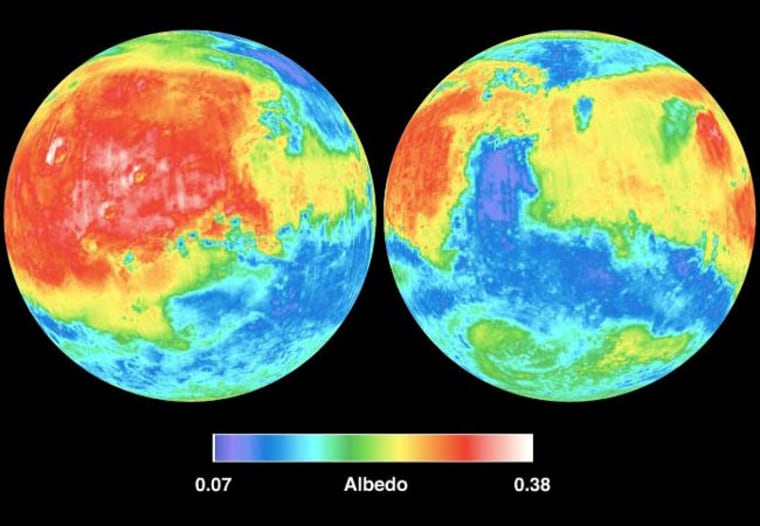Shifting dust storms on Mars might be contributing to global warming there that is shrinking the planet's southern polar ice caps, scientists say.
Computer simulations similar to those used to predict weather here on Earth show that the bright, windblown dust and sand particles affects Mars’ albedo—the amount of sunlight reflected from the planet’s surface.
The research, detailed in the April 5 issue of the journal Nature, suggests these albedo variations play an important role in the climate of Mars. It could also potentially explain how global dust storms are triggered on the red planet.
A darkening world
Researchers from NASA and the U.S. Geological Survey fed two albedo maps of the Martian surface into a computer model called the Mars general circulation model (MGCM).
The model calculated the surface temperature and wind intensity on Mars at the times the maps were made. Both maps show the same area on Mars, but one was made using Viking data collected in the late 1970s, while the other was created with Mars Global Surveyor data collected in recent years.
Across the past two decades, the model showed the surface temperature of Mars has increased by about 0.65 degrees Celsius (1.17 degrees Fahrenheit).
“That magnitude of change is comparable to what we’ve estimated for global warming on Earth over the last 100 years,” said study participant Paul Geissler of the USGS.
The model also found that winds have strengthened over regions with the lowest albedo.
The researchers think all these events are related and have proposed a mechanism by which lower albedo drives wind circulation, creating even lower albedo. They think it works like this: In regions where winds blow away dust, the exposed dark ground absorbs sunlight and heats up; some of this heat is transferred into the atmosphere and heats up the air. Just like on Earth, the imbalance in the atmosphere’s heat increases wind circulation above those regions.
“This could lead to a positive feedback effect in which the surface changes strengthen the winds that are producing the surface changes,” Geissler said in a telephone interview.
Winds of change
The wind speeds could ramp up until a threshold is reached, at which point conditions are ripe for a dust storm that swamps the entire planet, the researchers speculate.
Slideshow 12 photos
Month in Space: January 2014
“A dust storm is kind of like a big party that picks up dust and tosses it everywhere,” said study leader Lori Fenton of the NASA Ames Research Center in California. “It takes forever to clean up after a party.”
Once the dust storm subsides, particles fall out of the atmosphere and are redistributed over a large portion of the planet. “You can almost think of a big dust storm as a resetting mechanism,” Fenton told SPACE.com.
The researchers think they are on the right track because the computer model predicts a build-up of heat in the atmosphere above Mars’ southern hemisphere that is roughly equal to the amount of energy necessary to account for the diminishment of the planet’s southern polar ice caps that has been observed in recent years.
Scientists have struggled to explain the shrinkage and have blamed it on everything from fluctuations in the sun’s output to natural variations in the planet’s orbit and tilt.
“We haven’t really had a really good explanation for this in the past,” Geissler said. “We found that this mechanism could contribute or possibly explain the rapid sublimation of the south polar cap.”

